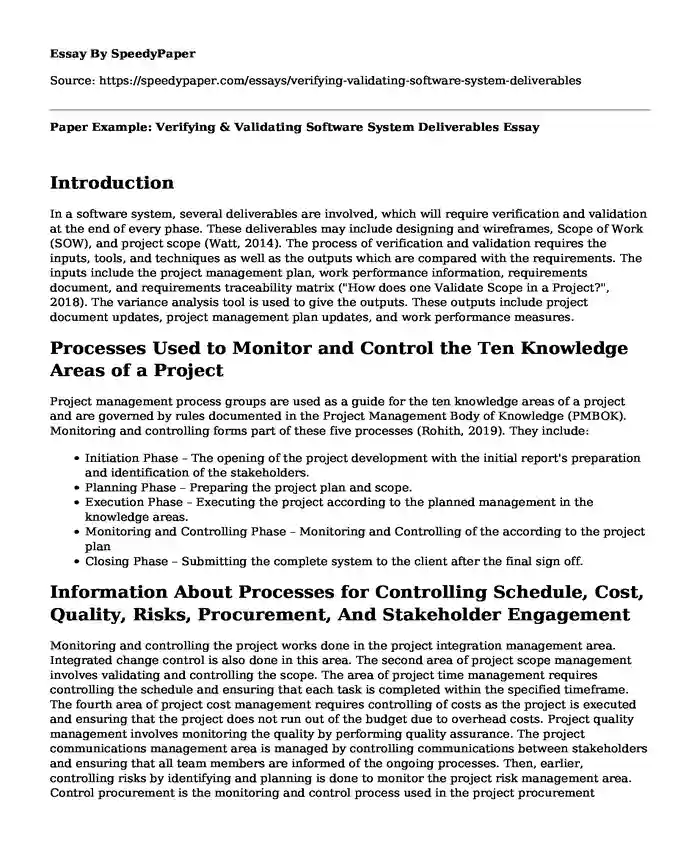
| Type of paper: | Essay |
| Categories: | Software |
| Pages: | 3 |
| Wordcount: | 696 words |
Introduction
In a software system, several deliverables are involved, which will require verification and validation at the end of every phase. These deliverables may include designing and wireframes, Scope of Work (SOW), and project scope (Watt, 2014). The process of verification and validation requires the inputs, tools, and techniques as well as the outputs which are compared with the requirements. The inputs include the project management plan, work performance information, requirements document, and requirements traceability matrix ("How does one Validate Scope in a Project?", 2018). The variance analysis tool is used to give the outputs. These outputs include project document updates, project management plan updates, and work performance measures.
Processes Used to Monitor and Control the Ten Knowledge Areas of a Project
Project management process groups are used as a guide for the ten knowledge areas of a project and are governed by rules documented in the Project Management Body of Knowledge (PMBOK). Monitoring and controlling forms part of these five processes (Rohith, 2019). They include:
- Initiation Phase – The opening of the project development with the initial report's preparation and identification of the stakeholders.
- Planning Phase – Preparing the project plan and scope.
- Execution Phase – Executing the project according to the planned management in the knowledge areas.
- Monitoring and Controlling Phase – Monitoring and Controlling of the according to the project plan
- Closing Phase – Submitting the complete system to the client after the final sign off.
Information About Processes for Controlling Schedule, Cost, Quality, Risks, Procurement, And Stakeholder Engagement
Monitoring and controlling the project works done in the project integration management area. Integrated change control is also done in this area. The second area of project scope management involves validating and controlling the scope. The area of project time management requires controlling the schedule and ensuring that each task is completed within the specified timeframe. The fourth area of project cost management requires controlling of costs as the project is executed and ensuring that the project does not run out of the budget due to overhead costs. Project quality management involves monitoring the quality by performing quality assurance. The project communications management area is managed by controlling communications between stakeholders and ensuring that all team members are informed of the ongoing processes. Then, earlier, controlling risks by identifying and planning is done to monitor the project risk management area. Control procurement is the monitoring and control process used in the project procurement management area.
Tools and Techniques for Validating Your Scope and Getting Verified Deliverables
Ideally, the scope validation is the formal acceptance of the final project deliverables. The scope validation is centered on customer acceptance. The tools and techniques involved include inspection and group decision-making techniques. In inspection, the Procurement Product Inspection is reviewed during the inception of a project, and criteria are developed in written format. The form lists the product's acceptance and the quality standards required, and it must be signed for it to be accepted.
The group decision-making is a participatory process that is comprised of multiple people who conduct problem or situation analysis and make considerations about evaluation od the alternative courses of action.
The other metrics used for scope validation are data analysis, which includes the variance and trend analysis and determining the root causes. In variance analysis, two comparable data points are investigated. The significant types of variance reviewed in project management include estimates versus actual, estimated versus planned and planned versus actual ("Variance & Trend Analysis," n.d.). This technique is significant in determining the cause and degree of variations between the actual performance and the baseline. The trend line as a visual plot helps to examine and identify spikes and dips in the data of the project aspects such as time, cost and deliverable over some time.
References
How does one Validate Scope in a Project? Invensis Learning. Invensis Learning - Certification Training Courses. (2018, June 29). https://www.invensislearning.com/resources/pmp/how-does-one-validate-scope-in-a-project.
Variance & Trend Analysis: Tools & Techniques | Study.com. (n.d.). Retrieved May 31, 2020, from https://study.com/academy/lesson/variance-trend-analysis-tools-techniques.html
Watt, A. (2014, August 14). 4. Framework for Project Management. Project Management. https://opentextbc.ca/projectmanagement/chapter/chapter-4-framework-for-project-management-project-management/.
Rohith. (2019, July 24). Knowledge Areas of Project Management | Edureka. Retrieved May 31, 2020, from https://www.edureka.co/blog/10-project-management-knowledge-areas
Cite this page
Paper Example: Verifying & Validating Software System Deliverables. (2023, Aug 16). Retrieved from https://speedypaper.net/essays/verifying-validating-software-system-deliverables
Request Removal
If you are the original author of this essay and no longer wish to have it published on the SpeedyPaper website, please click below to request its removal:
- Essay Example on the Implementation of Electronic Health Records
- Paper Example on Cloud Computing in Higher Learning Centers
- Essay Example: The Potential Abuses of Computer Technology
- Free Essay: The Installation of the Various Computer Equipment
- Paper Example. Practical Research on Mobile-Assisted Language Teaching in China Universities
- Essay Sample on Transoceanic Cables and the World of the Internet
- Influential Programming language for Business - Essay Sample
Popular categories




